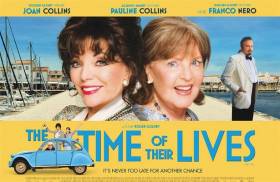Displaying items by tag: Time of Their Lives
#SeaFilm - Time of Their Lives, the latest film to star Dame Joan Collins saw the actress sail on a UK-France ferry looking to find love, adventure and true friendship.
In the film, Collins is joined by co-star Pauline Collins which sees the superstar actresses on board Brittany Ferries cruiseferry Mont St. Michel from Portsmouth to Caen, Normandy. The scenes were shot on board the cruiseferry last summer, to the delight of 500 passengers and French Captain Bertrand Cuvillier who hosted the stars for breakfast during the crossing.
On arrival of Mont-St.Michel in the French port, the film sees the pair head south in a Citroen 2CV. Love interest comes en-route courtesy of Italian heartthrob Franco Nero, before a dramatic finale on the beautiful island of Ȋle de Ré.
The Atlantic Ocean setting of Ȋle de Ré, Afloat adds is where one of the island harbour's Saint-Martin-de-Ré is designated a UNESCO World Heritage Site. The island is reached not by sea but a bridge connecting to the mainland near La Rochelle, the capital of the Charentes-Maritime department.
Accompanying the actresses were a 40 strong film crew, that shot scenes in the cruiseferry’s bar, on deck and from the port. All these scenes cinema-goers will see on the big screen.
The film premiered on Wednesday this week and advanced screenings took place on board the Brittany Ferries fleet on Thursday. This was followed by general release on Friday, both in the UK and Ireland. To see a trailer click here.
To celebrate the launch of The Time of Their Lives, Brittany Ferries has put together a three-night sail-and-stay break (albeit only available from the operators UK ferryports). For example on the Portsmouth-Caen route that replicates the character's voyage of discovery.
The offer includes two nights on the idyllic and glamorous Ȋle de Ré island, home to the rich and famous. The offer is available up until 30 June 2017.
Brittany Ferries which also operate a seasonal Ireland-France (Cork-Roscoff) route begins at the end of this month with Pont-Aven. The flagship is scheduled to make an inward bound crossing from France on 31 March.
On the following day, Pont-Aven departs Cork on 1 April to make the debut outward crossing to Roscoff. The overnight French route at 14 hours is the shortest and fastest crossing between Ireland and the continent.





























































